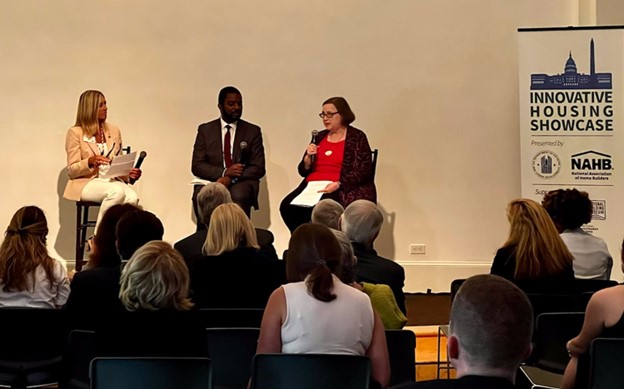Home Builders Flock to DC to Shed Light on ‘Housing Crisis’
Originally Published by: NAHB — June 9, 2022
SBCA appreciates your input; please email us if you have any comments or corrections to this article.
At a meeting today hosted by NAHB and the U.S. Department of Housing and Urban Development (HUD), NAHB Chairman Jerry Konter set the tone for the conversation by noting that “housing affordability is the top priority of NAHB members and we feel it should be the top priority of lawmakers and government officials.”

NAHB Chairman Jerry Konter opens the meeting with remarks about the importance of housing affordability.
HUD Secretary Marcia Fudge echoed Konter’s remarks. “We need to rethink housing," said Secretary Fudge. “If we do not address the housing crisis right now, we all will have failed.”
The meeting, held at the National Building Museum in Washington, served as a kickoff event for the Innovative Housing Showcase a three-day event on the National Mall featuring new building technologies and housing solutions to make housing more innovative, resilient and affordable for American families.
Today’s event featured a series of panels on how innovative building technology can bend the cost curve, and what public and private sectors can do to spur the adoption of this technology.
Before the first panel, an economic presentation by NAHB Chief Economist Rob Dietz and the National Multifamily Housing Council VP of Research Caitlin Sugrue Walter laid bare the issues facing the U.S. housing environment.

NAHB First Vice Chair Alicia Huey moderates a panel discussion at the meeting.
“We have a persistent housing deficit in the country and the costs to build are going up,” noted Dietz. “The time to address these issues is now, and we need to address them with market solutions and government policy changes.”
The first panel, moderated by Jenny Schuetz of the Brookings Institute, focused on incorporating innovative building techniques into common practice. Joan Glickman, Program Manager, Residential Buildings at the U.S. Department of Energy, touted some of the work her agency has done through its Advanced Building Construction initiative, including a recent award of $33 million for retrofitting homes in real-world trials.
Michael Parker, with home builder Ivory Homes in Utah, agreed that a focus on retrofitting existing homes would do much more for overall building energy efficiency than increasing requirements on new homes. He also noted that modular building practices are just coming into maturity in the U.S. after enjoying decades of success overseas. If more builders would take risks and try new technologies, the industry could rapidly advance.

HUD Secretary Marcia Fudge and other officials meet with NAHB Senior Officers Jerry Howard, Jerry Konter, Alicia Huey, Carl Harris and Buddy Hughes for a private discussion after the meeting.
NAHB First Vice Chair Alicia Huey moderated the next panel with newly confirmed Federal Housing Administration Commissioner Julia Gordon and Dr. Rodney Harrell from AARP. Commissioner Gordon noted that it is “the duty of the federal government to move quickly and make sure regulations are updated for new developments in home building, like accessory dwelling units.”
Harrell said that his group is seeing a disconnect between what people are asking for today compared to what demands home owners will being making of their homes in the future, especially around universal design. He noted that in addition to cooperation between government and industry, there needs to be a lot more public education on the issues.
Public pushback, especially in the form of NIMBYism, was a common theme across the panels. Getting the public to understand that the housing affordability crisis is tied to antiquated ideas about where and what type of housing is allowed to be built is a key challenge to delivering solutions.
The Innovative Housing Showcase opens Friday, June 10 on the National Mall in downtown Washington, D.C. The event will feature exhibitors and homes highlighting the technology that will be used to build the homes of the future. It is free and open to the public.
